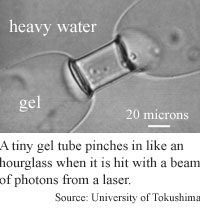
Lasers flex gel muscles
By Kimberly Patch, Technology Research NewsIn a development that could lead to better control of microscale devices, researchers from the University of Tokushima in Japan have shown that a laser beam can be used to quickly and accurately shrink and swell tiny coils of polymer gel.
Changes in properties like temperature and acidity can change the shape and size of polymer materials, but these changes occur over tens or hundreds of seconds. The laser method, however, allows the material to change in less than a second. The coils of gel range from 20 to 200 nanometers in diameter.
Systems using gel and laser beams could eventually be used for finely controlled drug delivery, molecular sorters or actuators for microelectromechanical systems (MEMS).
The researchers worked with cylinders of N-isopropylacrylamide polymer gel, a network of polymer molecules impregnated with water. They found that the photons of focused laser light cause a tweezers-like effect, pinching the chains of polymer's together, which forces water out, shrinking the material. The process reverses when the laser is switched off.
The process works because a gel is a delicate balance of forces that can be disrupted by adding energy to the system in the form of laser light. When this happens, the gel changes its composition, expelling water.
"A gel is near its volume phase transition at room temperature in water," said Hiroaki Misawa, an ecosystem engineering professor at the University of Tokushima.
The shape of a gel is determined by a balance of weak interactions among its molecules including hydrophobic, hydrophilic, van der Waals' and hydrogen bonding, said Misawa. "Once [the] balance is disturbed, a gel changes. Our experiments show that laser trapping can trigger [a] transition," he said. This allows the gel-laser system to work like a motor that converts photon energy to movement.
Earlier experiments have shown that the photons streaming from lasers can be used to move microscopic objects including dialectic, or non-conducting, substances. "We [took the next] step by showing that the polymer coils in the entangled polymer network can be affected by the laser trap as well," Misawa said.
Key to the successful pinching action was the researchers use of heavy water, which looks and flows like normal water, but has different chemical properties because its hydrogen atoms are replaced with the hydrogen isotope deuterium. Like hydrogen, deuterium has one proton and one electron, but also contains a neutron, making it heavier than ordinary hydrogen.
The heavy water contained in the gel does not absorb laser light energy like regular water would. This allows the heavy water to remain cool, while ordinary water would have been heated by the laser, affecting the gel adversely.
"People used laser traps to pick and place [microscopic] objects. What I haven't seen before is [this effect used to] induce a phase transition," said John Madden, a postdoctoral associate at the Massachusetts Institute of Technology (MIT). "They make a fairly convincing case that it is photon pressure [collapsing the gel] and I think it's actually quite exciting," he said.
The ability to quickly collapse tiny bits of gel opens up a number of practical possibilities. The gel could eventually be used to make light-controllable molecular sieves and finely controlled collapsible gel drug delivery systems, Misawa said. Drug release could be controlled inside the body by "focusing a beam through the skin and using that to activate a pump or open up a capsule in a of controlled way," said Madden.
In addition, layers of gels that have different sensitivities to light could form tiny actuators, or artificial muscle systems said Misawa. "The formation of the bi-layer gels in which one component is light-sensitive [could] be used to trigger bending action. Such actuators could possibly mimic muscle action."
The gel could be used in practical applications in five to ten years, Misawa said.
Misawa's research colleagues were Saulius Juodkazis, Naoki Mukai, Ryosuke Wakaki, Akira Yamaguchi, and Shigeki Matsuo. They published their research in the November 9, 2000 issue of Nature. The research was funded by the Ministry of Education, Science, Sports and Culture of Japan and the New Energy Industrial Technology Development Organization (NEDO).
Timeline: 5-10 years
Funding: Government
TRN Categories: Semiconductors and Materials; Nanotechnology
Story Type: News
Related Elements: Photo 1, Photo 2; Technical paper, "Reversible Phase Transitions In Polymer Gels Induced by Radiation Forces," Nature, November 9, 2000
Advertisements:
December 13, 2000
Page One
Nanotube fabric looms large
Silicon nanocrystals glow
Exploratory robot hops and rolls
Lasers flex gel muscles
Atomic scale wire speeds electrons

News:
Research News Roundup
Research Watch blog
Features:
View from the High Ground Q&A
How It Works
RSS Feeds:
News
Ad links:
Buy an ad link
| Advertisements:
|
 |
Ad links: Clear History
Buy an ad link
|
TRN
Newswire and Headline Feeds for Web sites
|
© Copyright Technology Research News, LLC 2000-2006. All rights reserved.